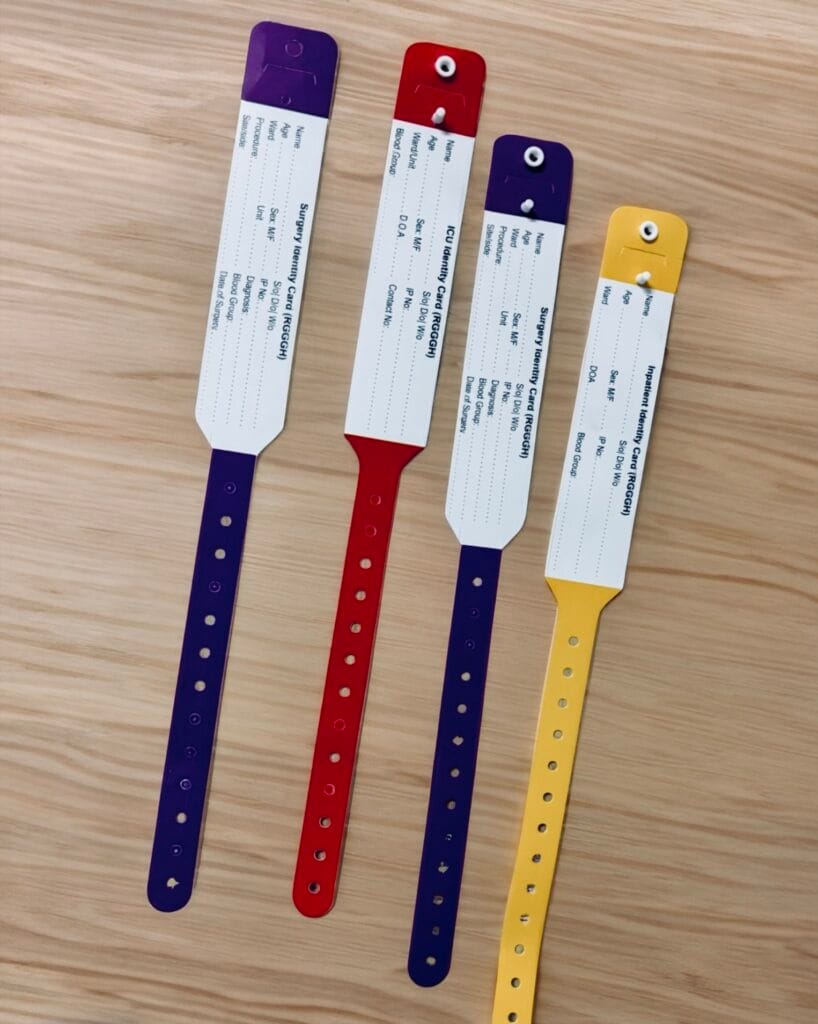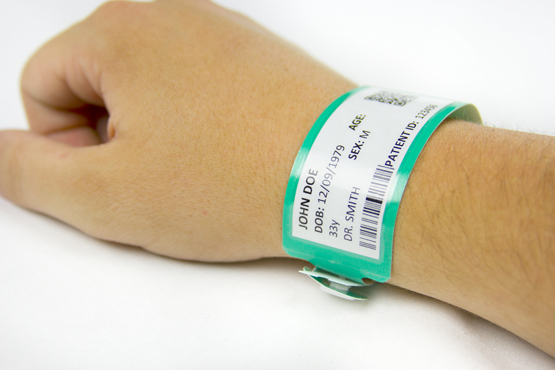Making Sure Specific Medicine Administration with Patient Identification Band
Why Client Recognition Bands Are Necessary for Every Healthcare Facility
In the complicated landscape of medical care, individual identification bands act as a foundational aspect in securing patient security and minimizing medical errors. These bands provide vital info that not just helps with accurate recognition yet also enhances communication among healthcare service providers. As institutions aim to satisfy regulatory conformity and boost total workflow effectiveness, the role of recognition bands becomes increasingly significant. The implications of their usage extend beyond mere compliance-- what are the prospective consequences of ignoring this essential technique? Discovering this concern reveals a much deeper understanding of client security and quality care.
Averting Medical Errors
In the world of medical care, avoiding clinical errors is extremely important to making certain person safety and high quality of care. One of one of the most crucial aspects in reducing such errors is the precise recognition of patients. Misidentification can lead to improper therapies, drug mistakes, and also surgical blunders, every one of which can have destructive consequences for clients and health care providers alike.
Patient recognition bands serve as a basic device in this preventive approach. These bands normally consist of important information, such as the patient's name, day of birth, and one-of-a-kind identification number, enabling medical care experts to confirm the patient's identification swiftly and properly before carrying out any type of treatment. Ensuring that these bands are properly applied and consistently used across all medical care setups is vital.
Furthermore, the application of digital health records (EHR) can enhance the efficiency of individual recognition bands by incorporating them with digital systems that flag prospective inconsistencies. Regular training and adherence to methods regarding making use of person recognition bands can dramatically reduce the possibility of errors. In recap, durable person identification techniques are vital for guarding and minimizing clinical mistakes individual well-being within healthcare atmospheres.
Enhancing Person Security
Individual safety and security is a multifaceted idea that incorporates various techniques and methods developed to shield people from injury throughout their health care experience. One important element in enhancing individual safety and security is the execution of individual identification bands. These bands act as an essential tool for guaranteeing that doctor can precisely determine patients, thus minimizing the risk of misidentification.
The presence of individual identification bands dramatically minimizes the possibilities of carrying out inaccurate medications, carrying out unexpected treatments, or falling short to recognize allergic reactions. By affixing a distinct identifier to every patient, healthcare facilities create a trusted system that cultivates accountability and watchfulness amongst clinical staff. This positive method not just improves the safety and security of patients however additionally instills a feeling of trust in the health care system.
Moreover, individual recognition bands add to a standard procedure that can be conveniently integrated into electronic health documents. Patient Identification Band. This combination makes certain that essential individual information is easily available, further reinforcing safety steps. Inevitably, the effective use recognition bands is a vital practice that underpins a culture of safety, aiming to secure clients and enhance general health care outcomes
Improving Communication
Efficient communication is necessary in the health care setting, as it straight affects individual safety and care high quality. Client recognition bands function as a critical device for enhancing communication amongst doctor. By plainly displaying vital patient details such as name, day of birth, and medical record number, these bands facilitate exact recognition, minimizing the risk of errors in therapy and drug administration.
In addition, person recognition bands promote a culture of liability and confirmation within health care teams. When all team member are geared up with immediate accessibility to reliable person recognition, the probability of miscommunication decreases considerably. For example, during handoffs between shifts or interdisciplinary consultations, the visibility of recognition bands ensures that everybody involved gets on the exact same web page pertaining to person identity and clinical history, thereby minimizing misconceptions.
In addition, these bands can integrate with digital health records (EHR), enabling smooth communication of person info across numerous platforms. This connectivity not just enhances the performance of information sharing however also supports a much more collaborated approach to individual treatment. Ultimately, the adoption of individual recognition bands is vital for enhancing interaction, hence contributing to much better health and wellness end results and guaranteeing that people get the highest possible criterion of treatment.

Streamlining Process
The implementation of individual identification bands dramatically contributes wikipedia reference to simplifying workflow within medical care environments. By supplying clear and instant identification of individuals, these bands reduce the time medical care specialists invest confirming patient info. This performance reduces the possibility for mistakes, allowing personnel to concentrate on direct client care as opposed to management jobs.
With standardized recognition procedures, his explanation healthcare groups can quickly access important patient data, including case history, allergies, and therapy strategies. This rapid gain access to boosts decision-making and enables prompt interventions, eventually enhancing person end results. Furthermore, using recognition bands facilitates much better sychronisation among multidisciplinary groups, making sure that all participants have the right details at their fingertips.

Additionally, person identification bands can be integrated with digital health record (EHR) systems, additionally optimizing operations. By scanning a band, doctor can promptly update and share information, consequently lowering redundancy and streamlining documentation efforts. This combination assists keep a continual circulation of information, which is vital in vibrant healthcare setups.
Ensuring Regulatory Conformity
In today's medical care landscape, guaranteeing regulatory conformity is vital for keeping person safety and organizational integrity. Patient identification bands play an essential role in meeting different regulative criteria, such as those set forth by the Joint Commission and the Centers for Medicare & Medicaid Provider (CMS) These organizations emphasize the necessity of accurate client recognition to reduce clinical errors and boost the top quality of care.

Executing standardized person recognition bands helps medical care centers follow regulations that need exact individual identification at every stage of care. This includes drug management, surgical procedures, and blood transfusions. Non-compliance can cause significant repercussions, consisting of penalties, loss of accreditation, and, most significantly, jeopardizing patient safety and security.
Furthermore, using modern technology, such as barcoding and RFID systems incorporated with individual identification bands, can additionally enhance conformity efforts by making certain that the best person gets the appropriate treatment at the correct time. By prioritizing the application of durable client recognition systems, medical care facilities not only comply with regulative criteria but likewise cultivate a culture of security and liability, inevitably improving individual outcomes and depend on in the healthcare system.

Verdict
To conclude, individual identification bands work as an essential part in health care facilities, dramatically adding to the prevention news of clinical errors and the enhancement of patient security. By improving interaction among clinical staff and enhancing workflows, these bands facilitate much more reliable healthcare distribution. In addition, their function in ensuring conformity with regulatory standards can not be overstated. Inevitably, the implementation of individual recognition bands is vital for cultivating a much safer medical care environment and improving general person outcomes.
In the complicated landscape of medical care, person recognition bands offer as a fundamental component in protecting individual safety and security and minimizing medical errors. These bands usually consist of crucial information, such as the patient's name, date of birth, and unique identification number, allowing health care experts to verify the individual's identification quickly and precisely before providing any type of care.Implementing standardized person recognition bands aids health care centers comply with policies that need specific individual recognition at every phase of care.In final thought, person recognition bands offer as an essential component in healthcare centers, dramatically adding to the avoidance of medical errors and the improvement of individual safety - Patient Identification Band. Ultimately, the implementation of person identification bands is essential for promoting a safer medical care atmosphere and improving total client outcomes